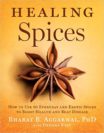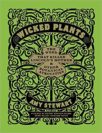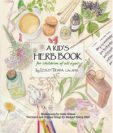I love to read – so much so, that I always have several books going at once. I still love to hold a physical book in my hands. However, I do listen to recorded books as I drive or fall asleep. The following books all center around herbs in one way or another, either as the main character or as an integral part to the subject. So my recommendation this holiday season is: give a book that revolves around herbs!
Since I’m covering eight books, I decided to list them alphabetically. Because of this, the first book just happens to be by yours truly.
A Kid’s Herb Book by Lesley Tierra (Crossing Press, latest printing 2017)
As a kid, I loved books about projects so I could make things. It’s no different today as I still enjoy various crafts. A Kid’s Herb Book grew out of this passion as my vision included not only writing a book to teach children about herbs, but also to emphasize hands-on projects. This book is packed with magical preparations, secret remedies, enchanting stories, and delightful songs that highlight 17 herbs great for kids or kids at heart, many of which can be found in your own kitchen or yard.
 Circe by Madeline Miller (Back Bay Books, New York 2018)
Circe by Madeline Miller (Back Bay Books, New York 2018)
The goddess, Circe, was given a bad rap in the Odyssey and even in the recent Game of Thrones series. And yet this fictional book, winner of the 2019 Indie Choice Award and named one of the “Best Books of 2016” by NPR and many national magazines, portraysa different woman through retelling her story with deep insight and understanding. We see through Circe’s own eyes and experiences that she is not malevolent but instead acts from both compassion and ignorance. As she discovers and uses herbs, she’s called a witch in all its negative connotations, and yet she’s a true woman healer. Metaphorically, Circe is about someone living as a victim but who slowly finds herself and eventually, takes charge of her life. A wonderful and enlightening read!
 Healing Spices by Bharat B. Aggarwai Ph.D. and Debora Yost (Sterling, New York, 2011)
Healing Spices by Bharat B. Aggarwai Ph.D. and Debora Yost (Sterling, New York, 2011)
This book changed my cooking life. I always had spices in the kitchen but after reading Healing Spices, I created an entire organized cabinetful that I use to this day. It covers 50 different spices and their healing benefits along with the other spices with which each pairs well and common recipes for its use. There’s also lots of research integrated along with information on buying spices with distinctions given between different varieties. An overall chart helps you create “Culinary Music.” This book is an inspiration, not to mention a great herbal kitchen resource.
 The Hidden Life of Trees, What They Feel, How They Communicate – Discoveries from a Secret World by Peter Wohlleben (Greystone Books, Vancouver, 2015)
The Hidden Life of Trees, What They Feel, How They Communicate – Discoveries from a Secret World by Peter Wohlleben (Greystone Books, Vancouver, 2015)
This eye-opening non-fiction work opens a window into the magical life of trees. Did you know that trees tell time; have a ‘tree phone network’ (wireless, too) and a “wood wide web,”; know when you are nearby; help increase plankton and thus, fish populations; and recognize and talk to their kin? This may all sound unreal, but The Hidden Life of Trees reveals such secrets and many more. Trees are incredibly community-oriented. They signal each other when under attack so the others can pump out insecticides to protect themselves. They share their storehouses and pool their resources to help other trees, especially through their secret underground mycorrhizal network. They also cooperate and take care of each other, healing other trees as well as feeding and nourishing each other when in need. Forests are superorganisms and there’s a crucial difference between original growth ones and those newly planted since they develop their own vital ecosystem. I could go on and on. An important read!
 The Overstory by Richard Powers (W.W. Norton & Co, New York, 2018)
The Overstory by Richard Powers (W.W. Norton & Co, New York, 2018)
Sometimes if a book is particularly good or especially captures my imagination, I’ll both read it in hand and listen to it. The Overstory was definitely one of these. This extraordinary novel is so poetically written, it can leave you meditating a long time on just one sentence. On the outside, it’s an exploration of people’s various relationships to trees and trees’ relationships to people, both in their healing power as well as the power of nature to drive people’s lives. But it’s mainly a treatise on the belief that the living world matters as much as do people. We are shaped by the forests as much as we shape them; people and trees are much closer than you think. Through a powerful story, this novel helps us wake from seeing people as supremely important to viewing the intelligence and presence of old forests as an equally integral and vital part of Planet Earth. A well-deserved winner of the Pulitzer Prize and “Best Book of 2018,” this book, crucial to our future, has my highest recommend!
 The Red Tent by Anita Diamant (Picador, New York, 1997)
The Red Tent by Anita Diamant (Picador, New York, 1997)
This book is an old fiction favorite and yet it’s well worth a re-read or at least introducing it to someone who has not read it. This book paints the life of women in the desert and cities of early Old Testament times. It revolves around Dinah, a student of midwives and eventually a midwife herself, speaking to the bond between women who share the power and vulnerability around giving life and the herbs that help this process. While it doesn’t teach what herbs to use, it paints a beautiful atmosphere of living close to the earth with her abundant healing gifts. A vivid, captivating novel that’s a must read if you haven’t already.
 The Road to Ubar, Finding the Atlantis of the Sands by Nicholas Clapp (Houghton Mifflin Company, New York 1998)
The Road to Ubar, Finding the Atlantis of the Sands by Nicholas Clapp (Houghton Mifflin Company, New York 1998)
This is a non-fiction work recounting the journey of a group of people searching for the fabled city Ubar in ancient Arabia. Located near the current town of Shisur a little distance from the current port of Salala in Oman, Ubar was a major village for the spice trade, particularly the frankincense that grows wild in the nearby Dhofar Mountains. Even the Queen of Sheba is said to have visited Ubar for this desirable incense. The author, a noted documentary filmmaker, searched years for this city and documents his experiences during this search. In doing so, he shares much of what he learned about the history of frankincense and its uses beyond pure incense.
 Wicked Plants: The Weed That Killed Lincoln’s Mother and Other Botanical Atrocities by Amy Stewart (Algonquin Books, Chapel Hill NC, 2009)
Wicked Plants: The Weed That Killed Lincoln’s Mother and Other Botanical Atrocities by Amy Stewart (Algonquin Books, Chapel Hill NC, 2009)
This book is great for those with a villainous appetite, or for the just plain curious. Many of us already know about hemlock killing Socrates, kudzu devouring cars and buildings in the American southeast, and tobacco claiming over 90 million lives a year. But did you know that the Nazis made poison bullets from the alkaloids in aconite (not to mention Professor Snape in the Harry Potter series brewing it to turn into a werewolf)? Or that castor bean was implicated in the “Umbrella Murder?” This A to Z book is rich in fascinating herbal stories and facts that will entertain, startle and inform gardeners and nature lovers. One section, Deadly Dinner, particularly captured my attention with its stories of the potential deadly effects of corn, rhubarb, kidney bean, cashew, potato and more. A fascinating read!

